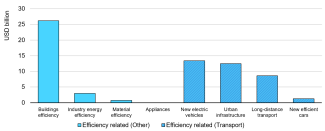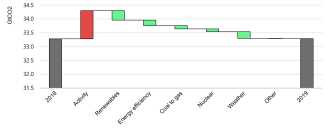Energy efficiency is expected to attract less investment and employ fewer people this year because of COVID-19 and the resulting recession, but it is still figuring notably into global economic recovery packages, according to the 2020 edition of the International Energy Agency’s (IEA) annual Energy Efficiency report released today. The new report also finds that efficiency helped offset 2019 increases in greenhouse gas emissions but at half the rate needed to meet climate goals.
Economic recovery packages
According to the IEA, more than $100 billion of clean energy-related recovery funding has been committed worldwide, of which more than half is going to efficiency-related spending. Europe dominates this spending, with more modest spending so far in Asia and North America. The largest share of investment is going to buildings efficiency, with major investments also in electric vehicles and urban infrastructure. as shown in the figure below.
Announced public efficiency-related stimulus funding by measure. Source: IEA Energy Efficiency 2020.
IEA recommends further recovery investment in energy efficiency, because efficiency is typically labor intensive, creating jobs, and has a low cost per ton for reducing greenhouse gas emissions.
Impact of COVID-19
The IEA report finds that efficiency investments are down about 9% in 2020 because of COVID-19 and the recession. Businesses and households have less overall to invest. But with people at home more, insulation sales were up 20-40% in Australia and online shopping for appliances is up in many countries.
More broadly, energy use has decreased in the transportation, industrial, and commercial sectors but increased in the residential sector. In transportation, the declines are particularly steep for aviation (down about 60%), but also across the board as people stay closer to home. Public transit use is down (50% in some countries), but walking and bicycling are up. One potential silver lining is that some airlines are retiring old, inefficient planes, so the remaining fleet is more efficient.
In industry, energy use is down because of factory shutdowns and reduced product demand. Office and retail shutdowns also reduce commercial-sector energy use, but residential energy use is up as more people work from home.
2019 greenhouse gas emissions
The IEA report looks at changes in greenhouse gas emissions between 2018 and 2019. It finds that energy-using activities increased in 2019, but the emissions did not increase because of a variety of factors including renewable energy, energy efficiency (the second largest contributor), coal-to-gas conversions, nuclear energy, and weather. The relative contributions of efficiency relative to other factors are shown in the figure below. Despite efficiency's contribution, energy intensity — energy produced per dollar of economic activity — improved only 1.6% in 2019, which is about half the amount that the IEA projects is needed to achieve long-term global climate goals. The report expects energy intensity to improve even less, 0.8%, in 2020.
Change in global energy-related CO2 emissions and avoided emissions, 2019 compared to 2018. Source: IEA Energy Efficiency 2020.
Conclusion
This has been an unusual and challenging year. The IEA report illustrates some of the challenges but also provides reason for hope, particularly if energy efficiency is a substantial part of economic recovery efforts, as is the case in a number of countries already and in President-elect Biden’s planned “Build Back Better” program.



